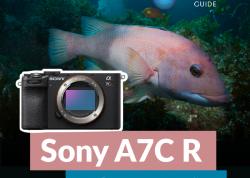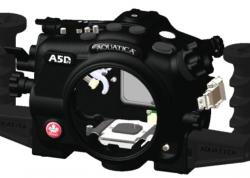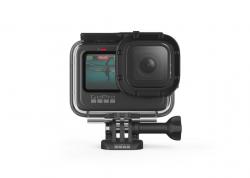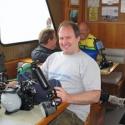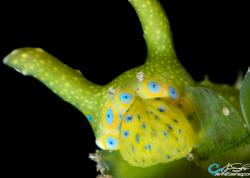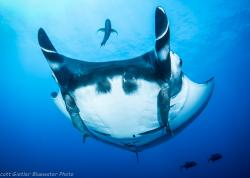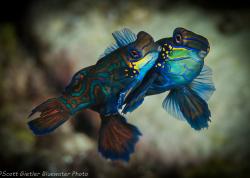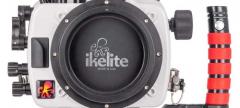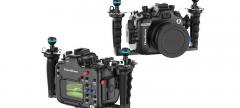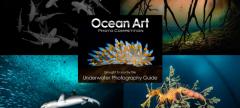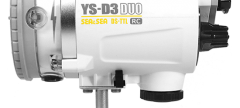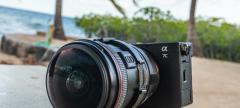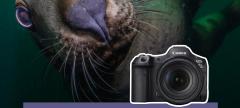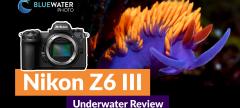Nikon D810 review for underwater photography
With 36 megapixels, lightning fast auto-focus, and one of the best sensors on the market, the Nikon D810 is a formidable camera. How does it stack up for underwater use? Pretty darn good! I've shot the camera on about 30 dives these last 2 weeks during my 5th annual Anilao underwater photo workshop for Bluewater Photo / Underwater Photography Guide, and I'm in love with the camera.
All of the following photos had minimal processing in Lightroom, usually adjustments in contrast, clarity, blacks, cropping, etc.
All photos were taken with either the Tokina 10-17mm fisheye lens, or the Nikon 105mm VR lens.
This review covers:
NIkon D810 wide-angle performace
Focusing speed
Macro
Supermacro
Nikon D810 colors underwater
Nikon D810 bokeh
Cropping with the D810
File sizes
Info for cropped sensor upgraders
Nikon D810 underwater lens selection
Nikon D810 underwater housings

Ribbon Eel, F10, 1/250th, ISO 100, Nikon 105mm VR lens

Cuttlefish, F14, 1/250th, ISO 125

100% crop of above cuttlefish photo, with part of the eye in the lower left corner
Nikon D810 - exceptional wide-angle underwater
Using the Tokina 10-17mm fisheye lens and the small 4-inch Zen glass dome port, I found the image quality & sharpness to be exceptional, and getting close for close-focus wide-angle was a breeze. I just left the Tokina 10-17mm fisheye lens at 15mm.

Starfish & sun, F16, 1/320th, ISO 100, Tokina 10-17mm fisheye lens

Crinoid & sun F18, 1/320th, ISO 100

100% crop of Crinoid/Sun photo above

Lionfish & boat, F14, 1/320th, ISO 100
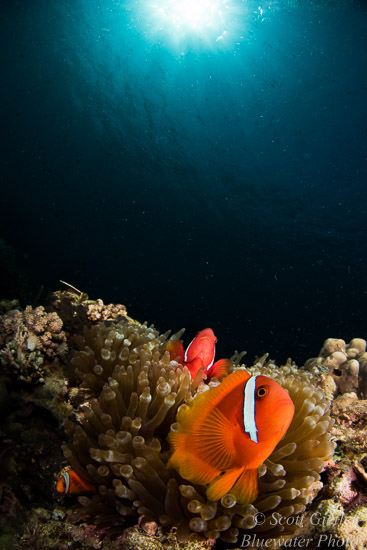
Clownfish & sun, F16, 1/320th, ISO 100
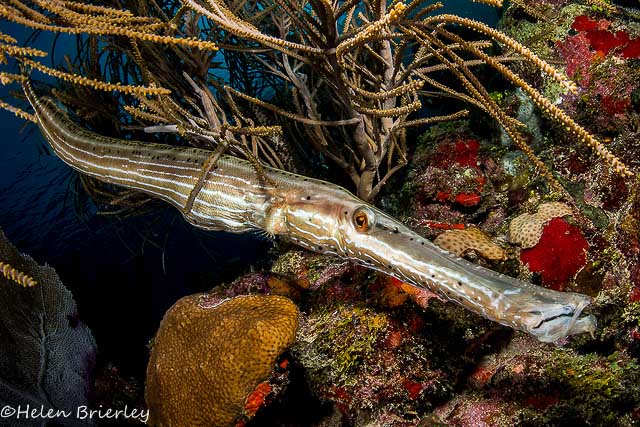
Trumpetfish, photo by Helen Brierley
Nikon D810 - wonderful auto-focus for behavior
The auto-focus on the D810 was nothing short of a miracle. Huge improvement over my NIkon D7000. None of my wide-angle photos were ever out of focus, for wide-angle I never had to think about auto-focus.
Using the Nikon 105mm VR lens, endless hunting was mostly a thing of the past. Even squid floating by at night were easily focused on - and I remember my lens hunting endlessly with my D7000.
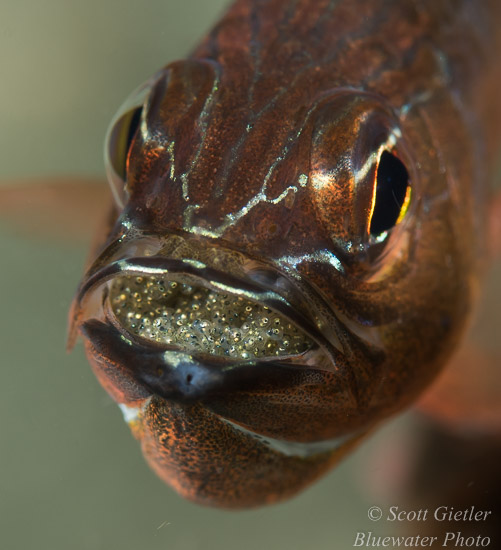
Cardinal fish with eggs brooding in mouth F10, 1/250th, ISO 200
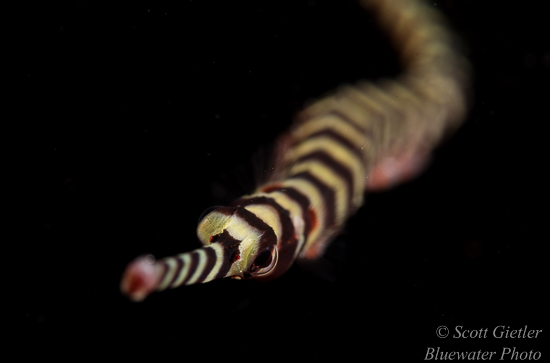
Coral banded pipefish, focus on eye F16, 1/250th, ISO 200

Cardinal fish with eggs brooding in mouth F14, 1/250th, ISO 250
Nikon D810 underwater macro - a brave new world
Using the 105mm VR lens on the D810 is like using both the 60mm and 105mm lenses at the same time on the D7200. Use the entire image to get the angle of view you would have with the Nikon 60mm lens on a D7100/D7200, or crop to get the image you would have had with the D7200 + 105mm VR lens with absolutely no loss of pixels or image quality.

Phyllodesmium nudibranch F18, 1/250th, ISO 200

Tiny pink-eyed goby F14, 1/250th, ISO 160

Crinoid shrimp F22, 1/250th, ISO 100

Gobies on tunicates feeding in current F16, 1/250th, ISO 100
Nikon D810 - Supermacro and beyond
Supermacro with the Subsee +10 or the Nauticam SMC was a breeze, just flip, move the lens forward, aim and shoot. Detail and sharpness was incredible - no, mind blowing.

X-mas tree worm closeup, F22, 1/250th, ISO 320

Face of shrimp on anemone F29, 1/250th, ISO 160

Mantis shrimp eyes, slightly cropped, taken with the Nauticam SMC diopter F20, 1/250th, ISO 320
Nikon D810 - great colors underwater
Using my dual Sea & Sea YS-D1 strobes, I got great colors with the D810 as long as I was close to the subject and not shooting through too much water. Since I like to keep my subjects just a few inches away, this was generally not a problem. Increasing the vibrance in lightroom often resulted in a more pleasing image without additional noise, unlike using the slider with my D7000.

X-mas tree worm closeup F13, 1/250th, ISO 100

Soft coral crab F25, 1/250th, ISO 200

Janolus nudibranch F14, 1/250th, ISO 125
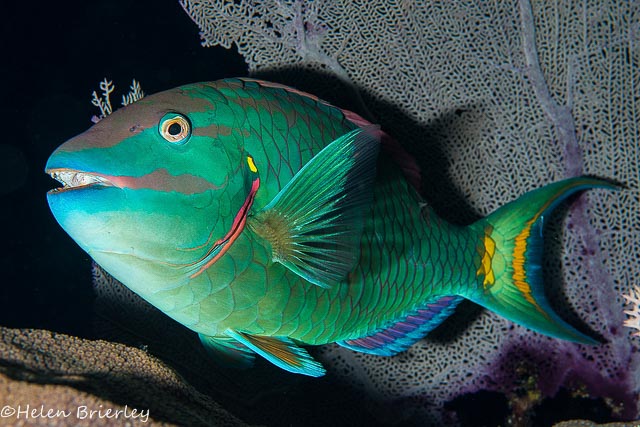
Parrotfish, photo by Helen Brierley
NIkon D810 - great bokeh underwater
The shallower depth of field of a full-frame camera means you can get great "bokeh", or background blur, in your underwater images.

Jawfish with eggs switching holes F13, 1/250th, ISO 100

Small goby F16, 1/250th, ISO 100

Male Anthias fish F9, 1/250th, ISO 100
Nikon D810 underwater - crop until you drop
Cropping is almost mandatory with the D810. With 36 megapixel images, 40 megapixel RAW files, and JPEG 7360 pixels wide - you have a lot of data. Unless you are Ansel Adams, you probably don't need it all. You can crop without fear, without shame, without losing detail.

Hairy squat lobster, heavily cropped to 1/4 the original image size, but this image is still 1800 pixels wide and very sharp when viewed at 1:1.
F20, 1/250th, ISO 160
Nikon D810 file sizes
At first, I have to admit I was a little intimidated by the large file sizes of the D810. However, I quickly found out that a single 32 GIG card easily held a full day of 4-dive shooting in 14-bit RAW + small JPEG for myself, and loading RAW images into lightroom was not any slower.
Regarding storage, I don't have the need to store thousands of images I never look at, each day I scan my jpegs, select 10 - 20 of the best images, load the RAW files into lightroom and delete the rest.
Info for D200 / D300 / D7000 / D7100 upgraders
Can I use my lenses?
Yes you can, including the Tokina 10-17mm fisheye, 60mm macro, 105mm VR macro. However, "DX" lenses like the Nikon 10-24mm, 12-24mm, or Sigma 17-70mm will put the camera in "DX mode' which will only (ha ha) give you 15.4 megapixels. However, you will dislike the smaller viewfinder image that DX mode gives you.
How will macro be different?
It will be better, totally awesome. When I use the 105mm on the D810, I have almost the same angle of view of the 60mm on a D7000, but with 36 megapixels instead of 16 megapixels.
I also have the exact same image as a D7000 shooter using the Nikon 105mm lens (if I were to crop the center of my larger image), but I also have all these extra pixels they don't have around that image, which gives me extra compositional options. So in effect, it is like I was shooting with the 60mm and 105mm macro lenses at the same time.
Can I use my existing ports?
Absolutely! Please note that wide-angle images will be slightly softer in the corners at the same aperture. You can either stop down more, or use a slightly larger dome port.
How will the viewfinder be different?
The viewfinder on a Nikon D800 / D810 is larger than the viewfinder on a cropped sensor camera. How much larger? I will try to quantify this an update this section shortly.
Compared with the Nikon D800
Images taken with the Nikon D800 and Nikon D810 are going to be very similar. The D180 does have many advantages - differences are in the better video capability, improved auto-focus speeds, faster shooting speeds (5 fps vs 4 fps), expanded ISO range (64 - 12,800 vs 100 - 6,400), longer battery life (33% better), much larger buffer capacity (up to double the size), quieter shutter and better LCD resolution (33% higher resolution).
With regards to sharpness, at 100% crops the D810 will be slightly sharper than the D800, although differences between the D810 and the D800E will be harder to detect.
If you don't own either camera, the D810 is the clear choice - especially for people like myself who will also use it for wildlife and therefore will take advantage of many of the improvements. But like I said - no perceivable differences in image quality.
Nikon D810 underwater lens selection
Wide Angle
Tokina 10-17mm fisheye - excellent choice - all wide-angle photos in this article were taken with the Tokina 10-17mm lens
Sigma 15mm fisheye - excellent choice
Nikon 16-35mm F4 - good choice, esp. for sharks, whales, dolphins
Sigma 12-24mm - good choice, esp. for sharks, whales, dolphins
Pool work
NIkon 24-70mm - good mid-range option
Macro
NIkon 105mm VR - awesome! All macro shots in this article were taken with the Nikon 105mm VR lens
Nikon 60mm - will work great, but I never feel the need to use it, the 105mm worked well for all my macro/fish shooting
Nikon D810 underwater housings
There are several excellent underwater housings for the Nikon D810. All of the housings are excellent, as the housing manufacturers have really stepped up their game in recent years.
Ikelite D810 underwater housing $1,800
Polycarbonate housing, includes built-in TTL converter for Ikelite strobes, great value. See recommended lenses, ports and strobes
Aquatica D810 underwater housing $3,530
Aluminum housing, holds up excellent in extreme conditions. Large control dials. See recommended ports, lenses & strobes
Sea & Sea D810 underwater housing $3,500
Aluminum housing, optional internal TTL converter, smaller size, solid ergonomics. See recommended ports, lenses, & strobes.
Nauticam D810 underwater housing $3,700
Aluminum housing, optional flash trigger for faster shooting, great ergonomics & easy port changes. See recommended ports, lenses & strobes.
Aquatech D810 Surf housing $995
Good, inexpensive option for surf shots, pool work where ability to use all controls or going deep is not as important.
Nikon D810 for underwater - conclusions
I had several concerns about moving to full-frame - I would lose the flexibility of the Tokina 10-17mm fisheye; I would have less ability to do supermacro; fill sizes would be unwieldly. It turns out none of these concerns were valid - I can do equal or better supermacro as a cropped sensor camera, and I still have the same flexibility with wide-angle as cropped sensor users - just via cropping instead of zooming, but with no less resolution. File sizes were not more difficult to store/process.
Although the Nikon D810 costs more, and the setup is slightly heavier, the pros are huge and I give it a huge 2 thumbs up.
RECOMMENDED ARTICLES
SUPPORT THE UNDERWATER PHOTOGRAPHY GUIDE:
The Best Service & Prices on u/w Photo Gear
 Visit Bluewater Photo & Video for all your underwater photography and video gear. Click, or call the team at (310) 633-5052 for expert advice!
Visit Bluewater Photo & Video for all your underwater photography and video gear. Click, or call the team at (310) 633-5052 for expert advice!
The Best Pricing, Service & Expert Advice to Book your Dive Trips
 Bluewater Travel is your full-service scuba travel agency. Let our expert advisers plan and book your next dive vacation. Run by divers, for divers.
Bluewater Travel is your full-service scuba travel agency. Let our expert advisers plan and book your next dive vacation. Run by divers, for divers.




